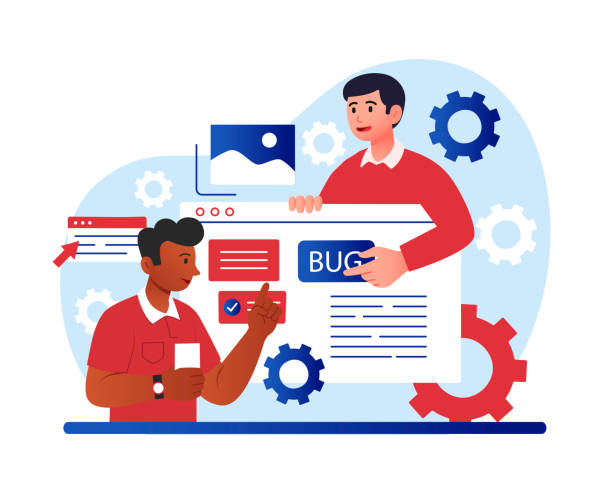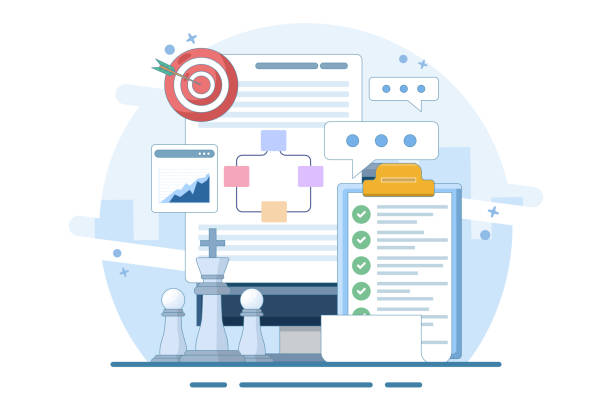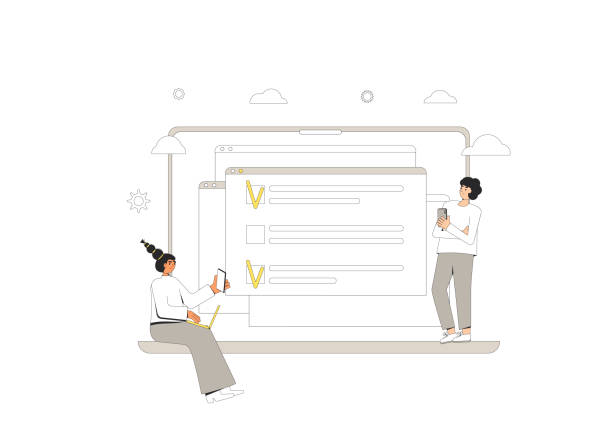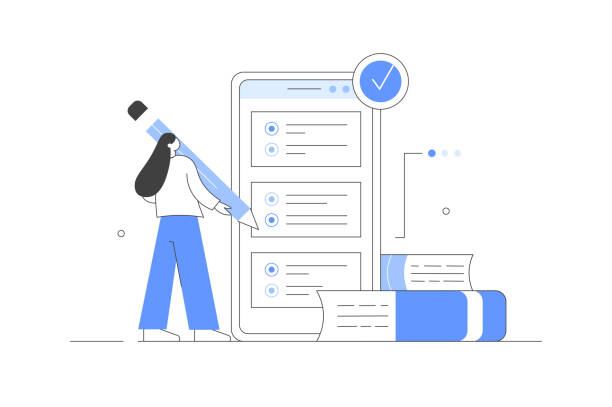Introduction to the Importance of Secure Website Design in Today’s World

In the current digital age, where every business and individual has an online presence, secure website design is no longer an option, but an undeniable necessity.
Your website not only represents your digital identity but also serves as a gateway to sensitive user information and your business data.
Therefore, #security, #data_protection, and #user_trust are among the most important challenges facing web designers and developers.
Imagine a website facing a security breach; this could lead to loss of reputation, heavy financial damages, and even legal penalties.
Hence, the importance of the #website_security_process and implementing web security principles is magnified from the initial stages of secure website design.
This section, in an explanatory and educational manner, clarifies the reasons for its importance and familiarizes you with the general concept of website security.
From black-hat hackers to sophisticated malware, cyber threats are constantly evolving, and only with a secure and stable website design can one stand against them.
This article helps you become familiar with the principles and best practices of secure website design and build a website that is not only efficient but also resilient against cyber attacks.
Are you bothered by losing customers due to your online store’s outdated appearance or slow speed? Rasaweb’s expert team solves these problems with professional e-commerce website design!
✅ Increase customer trust and brand credibility
✅ Stunning speed and excellent user experience
Get a free consultation with Rasaweb now ⚡
Familiarity with the Most Common Vulnerabilities and Cyber Threats

Before delving into secure website design, it is essential to become familiar with the enemies of this security.
Cyber attacks come in various forms, each capable of harming your website in different ways.
Understanding these vulnerabilities is the first step towards building a secure website.
Among the most common threats are SQL Injection, through which hackers infiltrate databases and steal sensitive information.
Cross-Site Scripting (XSS) is also an attack that leads to the injection of malicious code into web pages and can affect users’ browsers.
Distributed Denial of Service (DDoS) attacks overwhelm the website with a huge volume of traffic, making it unavailable.
In addition, other vulnerabilities such as Broken Authentication, Insecure Deserialization, and Security Misconfiguration can create critical weaknesses in your website’s security system.
This section, specialized and analytical, elaborates on these threats and prepares you to counter them in the secure website design process.
A deep understanding of these attacks provides you with the necessary insight to implement strong defense mechanisms and significantly helps improve web security resilience.
Ignoring these issues can render your efforts in secure website design ineffective.
Best Practices in Secure Backend Coding

The beating heart of any website is its backend, which manages the main program logic and interaction with the database.
To achieve secure website design, special attention to secure coding in this layer is vital.
One of the most important principles is Input Validation.
Any data received from the user must be carefully checked and sanitized to prevent the injection of malicious code.
Using Prepared Statements is essential to prevent SQL Injection attacks; this method ensures that user inputs are never interpreted as part of the SQL code.
Proper error and log management is also crucial; general error messages should be displayed to the user, and technical details should only be recorded in server logs to prevent the disclosure of sensitive information.
Furthermore, encrypting and hashing user passwords before storing them in the database is a security requirement.
Using strong algorithms like bcrypt is recommended.
Session and token management must also be done carefully, ensuring that sessions expire after a certain period to prevent Session Hijacking attacks.
This section, specialized and guidance, addresses these principles and provides practical solutions for website security in the backend layer.
In the following, a table of some of the most important measures for secure website design in the backend is provided:
| Security Measure | Description | Prevents Attacks |
|---|---|---|
| Input Validation | Ensuring the correctness and security of user-provided data | SQL Injection, XSS, Path Traversal |
| Using Prepared Statements | Separating SQL code from user input data | SQL Injection |
| Password Hashing | Storing passwords as hashed values (with Salt) | Password Cracking, Brute-force |
| Proper Session Management | Using secure cookies (HTTPOnly, Secure) and session expiration | Session Hijacking, Session Fixation |
| Rate Limiting | Limiting the number of requests from an IP or user | Brute-force, DoS/DDoS |
Securing Frontend and User Interactions

The frontend of a website is where users directly interact, and for this reason, its security should not be overlooked.
Although most serious attacks occur in the backend layer, frontend vulnerabilities like Cross-Site Scripting (XSS) can lead to session information theft or page content alteration.
For secure website design in the frontend, the Same-Origin Policy (SOP) must first be used correctly to prevent unwanted interactions between domains.
Additionally, using Content Security Policy (CSP) adds a powerful security layer that allows the browser to distinguish authorized resources (scripts, stylesheets, images) from untrusted sources and prevent malicious code from loading.
All sensitive information should not be stored client-side, and avoid storing important data in Local Storage or Session Storage without proper encryption.
Ensuring the use of HTTPS for all communications is also a fundamental principle.
SSL/TLS certificates encrypt data between the user’s browser and the server, preventing Man-in-the-Middle attacks.
This section, guidance and specialized, discusses web security methods on the user side and provides solutions for secure interaction and web security resilience in the user interface.
Paying attention to these points in secure website design provides a safer user experience for your visitors.
Did you know that 94% of a company’s first impression is related to its website design?
Rasaweb, by offering professional corporate website design services, helps you create the best first impression.
✅ Create a professional and trustworthy image for your brand
✅ Easier attraction of potential customers and improvement of online standing
⚡ Get a free corporate website design consultation
Server and Hosting Security: Choosing a Secure Host

Your website’s hosting infrastructure is the foundation of your secure website design.
Choosing a secure host and proper server configurations plays a vital role in protecting your website against attacks.
A reputable web host should offer security features such as a Web Application Firewall (WAF), Intrusion Detection and Prevention Systems (IDS/IPS), and regular support for SSL/TLS certificates.
Servers must be updated periodically to address known security vulnerabilities in the operating system and application software (such as Apache, Nginx, PHP, Node.js).
Additionally, restricting access to files and folders (File Permissions) to the bare minimum prevents unauthorized access to information.
Using Content Delivery Networks (CDN) not only increases your website’s speed but can also act as an additional defense layer against DDoS attacks.
Monitoring server logs to identify suspicious activities is also an important preventive measure.
This section, in an explanatory and guidance manner, explains the importance of correct host selection and secure server configuration for your website security.
A comprehensive approach to secure website design must also include security at the server and hosting layers to ensure the highest level of protection.
Paying attention to technical details and following news related to server vulnerabilities can also help you maintain web security resilience.
The Importance of Regular Security Audits and Penetration Testing

Even with the best implementations in secure website design, websites are always exposed to new threats.
Cyber attack techniques are rapidly evolving, and new vulnerabilities are constantly being discovered.
Therefore, performing regular security audits and Penetration Testing is essential for any website.
Penetration testing involves simulating real cyber attacks by security experts to identify and fix weaknesses and vulnerabilities before they are discovered by hackers.
This process can include automated and manual tests and helps you assess your web security resilience against the latest threats.
In addition to penetration testing, regular Code Audits and Vulnerability Scans are also recommended.
These measures not only help identify current problems but also provide valuable insights for continuous improvement of secure website design in the future.
This section, analytical and educational, discusses the importance of these processes and encourages you to consider them an integral part of your website security strategy.
Ignoring these tests can lead to unpleasant surprises and jeopardize all your previous efforts to build a secure website.
Data Protection and Compliance with Privacy Laws

In today’s world, protecting user data and respecting their privacy is of paramount importance.
Strict laws and regulations such as GDPR (General Data Protection Regulation) in Europe and CCPA (California Consumer Privacy Act) in the US have set new requirements for how user personal information is collected, stored, and processed.
Secure website design must consider these laws to prevent heavy fines and loss of user trust.
This includes transparency about data usage, obtaining explicit consent from users, and the ability to access, correct, or delete their personal data.
Implementing data encryption in transit and at rest, restricting data access only to authorized personnel, and appropriate protocols for responding to data breaches are key principles in this area.
Even in the initial stages of secure website design, the system architecture should adhere to Privacy by Design principles.
This section, news-oriented and specialized, examines these laws and practical solutions for data protection within the framework of website security.
Adhering to these points is not only legally necessary but also significantly helps increase user trust in your website and plays an important role in web security resilience.
The table below provides a comparison between two important privacy laws that are crucial for secure website design and privacy compliance:
| Feature | GDPR (Europe) | CCPA (California, USA) |
|---|---|---|
| Effective Date | May 2018 | January 2020 |
| Scope | Organizations processing data of EU citizens (regardless of location) | Organizations earning revenue from California citizens’ data (with revenue/user count conditions) |
| Definition of Personal Data | Any information relating to an identified or identifiable natural person | Information that identifies, relates to, describes, is reasonably capable of being associated with, or could reasonably be linked, directly or indirectly, with a particular consumer or household |
| Key User Rights | Right to access, right to rectification, right to erasure, right to data portability, right to object | Right to know, right to access, right to deletion, right to opt-out of sale of personal information |
| Penalties | Up to €20 million or 4% of annual global turnover (whichever is higher) | State penalties up to $7,500 per intentional violation, private right of action up to $750 per consumer |
Disaster Recovery and Backup Strategies

Even with the most meticulous approach in secure website design, the probability of unpredictable disasters such as hardware failure, successful cyber attacks, or human error is never zero.
In such situations, having a comprehensive strategy for Disaster Recovery and planning for regular Backup is crucial.
Regular and automatic backups of all website data, including files, database, and server configurations, are your first line of defense.
These backups should be stored in secure and separate locations (off-site from the main server) to be accessible in case of an issue with the main server.
It is also important that the recovery process from backups is tested periodically to ensure they function correctly when needed.
Disaster recovery planning includes defining the Recovery Time Objective (RTO) and the maximum tolerable data loss (RPO – Recovery Point Objective).
This section, guidance and specialized, addresses the importance of these strategies in completing the website security process.
These measures not only guarantee your web security resilience but also give you peace of mind that under any circumstances, you will be able to restore your website to normal, and your efforts in secure website design will not be lost.
Tired of your e-commerce website not generating as much revenue as its potential? Rasaweb, specializing in professional e-commerce website design, solves this problem forever!
✅ Increase sales rate and revenue
✅ High loading speed and exceptional user experience
⚡ Get a free e-commerce website design consultation
The Role of User Education and Internal Security Policies

The weakest link in any security chain is often the human factor.
Even the most advanced secure website design system can be compromised by a user’s or employee’s error.
Therefore, educating users and employees on cybersecurity best practices is an essential component of the website security strategy.
These trainings should cover topics such as creating strong and unique passwords, identifying phishing emails and suspicious links, the importance of using two-factor authentication (2FA), and reporting any suspicious activity.
Additionally, implementing strong internal security policies within the organization can help mitigate risks.
These policies can include restricting access to sensitive information based on role (Least Privilege Principle), security protocols for remote work, and clear guidelines for using personal devices in the workplace.
Creating a security culture within the organization, where everyone takes responsibility for protecting data and systems, is of high importance.
This section, educational and sometimes entertaining (by providing examples of common mistakes), addresses the importance of this topic and shows how proper education can complement technical efforts in secure website design.
Ultimately, web security resilience is not just a technical issue but also a cultural one that requires widespread awareness and cooperation.
New Tools and Technologies in Web Security

The world of secure website design is constantly evolving, and with the emergence of new threats, new tools and technologies are being developed to counter them.
Familiarity with these tools and their use can help you achieve website security more effectively.
Among these tools are Web Application Firewalls (WAF), which act as a protective shield and filter incoming and outgoing website traffic to prevent common attacks.
Security Information and Event Management (SIEM) systems help identify suspicious patterns and potential attacks by collecting and analyzing logs from various sources.
Using Automated Vulnerability Scanners significantly helps in quickly identifying weaknesses in code and configuration.
Also, Blockchains and blockchain-based technologies are being explored for security applications such as decentralized authentication and secure data storage.
Artificial Intelligence (AI) and Machine Learning (ML) are also playing a crucial role in anomaly detection and predicting cyber attacks.
This section, analytical and news-oriented, introduces these emerging technologies and provides forward-looking solutions for web security resilience.
By staying up-to-date with these advancements, you can ensure that your secure website design is always on the front line of defense.
Frequently Asked Questions
| Row | Question | Answer |
|---|---|---|
| 1 | What is secure website design? | The process of designing and developing websites that are resistant to cyber attacks and protect user data and privacy. |
| 2 | Why is website security important? | To prevent data breaches, financial losses, damage to company reputation, and maintain user trust. |
| 3 | What are some common website security threats? | SQL Injection, XSS (Cross-Site Scripting), CSRF (Cross-Site Request Forgery), weak authentication, and outdated software. |
| 4 | What is SSL/TLS and what role does it play? | Protocols for encrypting data between the user’s browser and the website server, ensuring secure and private communication. |
| 5 | How can SQL Injection attacks be prevented? | By using Prepared Statements/Parameterized Queries, input validation, and ORMs (Object-Relational Mappers). |
| 6 | What is the role of a Web Application Firewall (WAF) in security? | A WAF monitors and filters HTTP traffic between a web application and the Internet to prevent malicious attacks. |
| 7 | Why are regular software and library updates necessary? | Updates include patches for known security vulnerabilities that attackers can exploit. |
| 8 | How can XSS attacks be prevented? | By sanitizing and escaping all user inputs before displaying them on the web page and using Content Security Policy (CSP). |
| 9 | What does the Principle of Least Privilege mean? | It means that users and systems are given only the minimum permissions necessary to perform their tasks, to prevent unnecessary access to resources. |
| 10 | What is the importance of proper user session management? | To prevent user session hijacking and unauthorized access to user accounts through secure and expiring session tokens. |
And other services of Rasaweb Advertising Agency in the field of advertising
Smart Data Analysis: A combination of creativity and technology for online growth using real data.
Smart Website Development: A novel service to enhance campaign management through key page optimization.
Smart Marketplace: An effective tool to improve SEO ranking with the help of Google Ads management.
Smart Brand Identity: Designed for businesses seeking digital branding through the use of real data.
Smart Reportage: A novel service to increase user engagement through attractive UI design.
And over a hundred other services in the field of internet advertising, advertising consultation, and organizational solutions
Internet Advertising | Advertising Strategy | Advertorial
Sources
Fundamentals of Website Security
Guide to Secure Web Design
Digital Future Trends
Best Practices for Secure Coding
❓ Are you looking for transformation and sustainable growth in your online business? Rasaweb Afarin, by providing comprehensive digital marketing solutions including secure website design, SEO, and social media management, paves your way to success. Trust us to make your brand shine in the digital space and achieve your goals.
📍 Tehran, Mirdamad Street, next to Bank Markazi, Kazeroun Jonoubi Alley, Ramin Alley, No. 6



